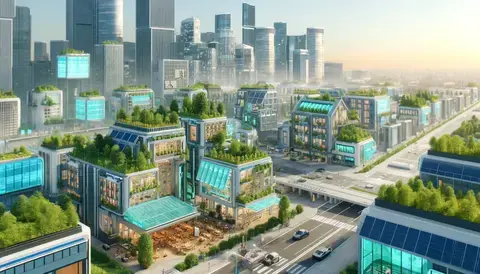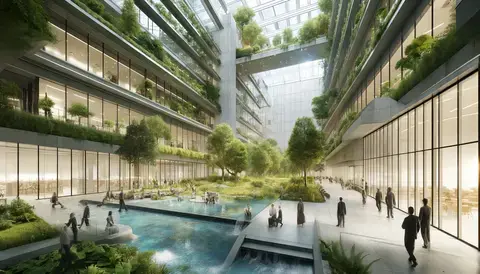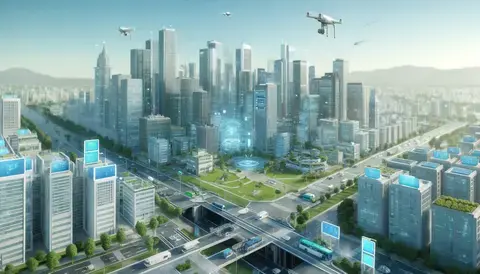Future Trends in Architecture
Emerging Architectural Trends 2024: Designing Tomorrow’s Spaces Today

Did you know the first entirely solar-powered community is currently being developed? This marks a significant step toward sustainable living, emphasizing how deeply environmental consciousness is shaping modern architecture.
An explorative journey through the future trends in architecture, where innovative designs meet sustainable practices to redefine our built environments. This article gets into how the latest advancements and societal shifts are shaping the architectural landscapes of tomorrow.
Sustainability Takes Center Stage:
- Introduction: Sustainability is now a cornerstone in architectural design, reflecting a global commitment to environmental responsibility.
- Significant Trends: From the integration of green roofs to the use of eco-friendly materials, explore how sustainability is becoming the norm in construction.
- Summary: The drive towards sustainable architecture is not just about reducing environmental impact but also enhancing the quality of life for urban dwellers.
Sustainability
Introduction: Sustainability has shifted from a niche concern to a central focus in architectural design, underlining a worldwide dedication to environmental stewardship. As climate change and resource depletion become more pressing, architects and builders are responding with innovative solutions that prioritize the planet's health without compromising on aesthetic or functionality.
Significant Trends:
- Green Roofs: These living roof systems not only reduce heat absorption, leading to lower energy costs, but also contribute to urban biodiversity and stormwater management.
- Eco-Friendly Materials: The use of recycled, renewable, and sustainably sourced materials is on the rise. Materials like bamboo, reclaimed wood, and recycled steel are becoming popular choices for their low environmental footprint.
- Energy Efficiency: High-performance building envelopes, solar panels, and smart energy systems are becoming standard, aimed at reducing the energy consumption of buildings.
- Water Conservation: Rainwater harvesting systems and water-efficient fixtures are increasingly incorporated to minimize water usage.
- Sustainable Urban Planning: Incorporating green spaces and promoting walkability to ensure sustainable urban environments that enhance community well-being.
Summary: The push towards sustainable architecture reflects a broader cultural shift towards sustainability that extends beyond mere environmental benefits. These design practices aim to improve the overall quality of life for urban dwellers by creating healthier living environments, reducing operational costs, and conserving resources. As sustainability takes center stage, it redefines the architectural landscape, promising a greener, more resilient future for urban development.
Biophilic Design: Blending Nature with Architecture:

- Introduction: Discover how architects are bringing elements of nature into urban spaces to benefit mental health and well-being.
- Examples of Biophilic Design: Tour some of the most innovative projects that seamlessly integrate natural elements, such as indoor forests and water features.
- Summary: Biophilic design is proving that urban spaces can be green havens, improving our connection to nature and enhancing urban living.
Biophilic Design:
Introduction:
Biophilic design is transforming urban environments by integrating natural elements into architectural projects. This approach is not only aesthetically pleasing but also enhances mental health and well-being. By incorporating components of the natural world into buildings and urban spaces, architects aim to create more invigorating, healthy living environments.
Examples of Biophilic Design:
- The Edge in Amsterdam: Known as one of the greenest buildings in the world, it features a full-height atrium filled with green plants and a smart LED lighting system that mimics natural light patterns.
- Khoo Teck Puat Hospital in Singapore: This hospital goes beyond conventional design by integrating lush gardens, natural ventilation, and water features, creating a healing environment that reduces stress for both patients and staff.
- Bosco Verticale in Milan: These residential towers are famous for their vertical forests that decorate the facades, hosting over 900 trees and more than 2,000 plants.
Module Summary:
Biophilic design is rapidly proving its value in urban development. It not only reconnects urban dwellers with nature, often lacking in city settings but also promotes sustainability. These green havens are vital in modern architecture, offering a dual benefit of improving quality of life while promoting ecological stewardship. This approach is expected to gain even more traction as cities continue to grow and seek sustainable and health-promoting strategies.
Smart Homes and Cities: The Technological Frontier

- Introduction: The rise of smart technologies is transforming homes and cities into interconnected ecosystems that enhance residents' lifestyles.
- Impact of IoT in Architecture: See how IoT is being employed to make buildings smarter and cities more livable.
- Summary: As technology evolves, so does the landscape of our cities, making them smarter and more efficient.
Smart Homes & Cities:
Introduction:
Smart homes and cities represent a significant leap forward in integrating technology into our daily environments. With the rise of smart technologies, homes and cities are transforming into interconnected ecosystems that significantly enhance the lifestyle and efficiency of residents.
Impact of IoT in Architecture:
The Internet of Things (IoT) is revolutionizing the way buildings and cities function, turning them into responsive and adaptive environments. Here are some key applications:
- Energy Management: IoT devices help in monitoring and managing energy consumption in real time, leading to significant reductions in energy waste.
- Security Enhancements: Smart security systems can identify threats more accurately and provide real-time updates to residents and authorities.
- Efficiency in Public Services: In cities, IoT can help manage everything from traffic and public transportation to water and waste management, improving overall city efficiency and livability.
Module Summary:
The landscape of our urban environments is rapidly evolving through the adoption of smart technologies. This evolution is making our cities smarter and more efficient, significantly improving the quality of life. The integration of IoT into the fabric of architecture is not just a trend but a transformational shift that is reshaping how we interact with the places we live and work. As technology continues to advance, the potential for smarter living and urban spaces becomes increasingly attainable and impactful.
Modular and Prefabricated Construction: Speed and Efficiency:
- Introduction: Prefabrication is revolutionizing the construction industry by reducing build times and waste.
- Case Studies: Highlight successful implementations of modular construction in residential and commercial projects.
- Summary: Modular and prefabricated designs are setting new standards in construction efficiency and flexibility.
Modular and Prefabricated Construction
Introduction
Prefabrication is making waves in the construction industry, offering a path to dramatically reduce build times and minimize waste. This approach involves assembling large segments of a building in a factory setting, which are then transported to the construction site ready to be pieced together like a giant jigsaw puzzle. This method not only speeds up the construction process but also improves quality control and reduces on-site labor.
Case Studies
- Residential Project in Oregon: This project utilized prefabricated panels to erect a two-story home in just three days, as opposed to weeks, demonstrating significant time savings.
- Commercial Development in Sweden: A series of office buildings were constructed using modular units, each floor being added in sequence with precision, showcasing the scalability of prefabricated methods in commercial real estate.
Summary
Modular and prefabricated construction are not just about speed; they embody a shift towards more sustainable and efficient building practices. By reducing the time spent on site and the amount of waste generated, these methods are setting new standards in the construction industry. They offer enhanced flexibility, allowing buildings to be expanded or reconfigured with minimal disruption. This module has illustrated that with the right approach, building projects can achieve unprecedented levels of efficiency and adaptability.
Adaptive Reuse: Sustainability Through Innovation:
- Introduction: Explore how architects are repurposing old buildings to give them new life, conserving resources and preserving history.
- Examples of Adaptive Reuse: From converted factories to revamped historical buildings, discover projects that exemplify creative reuse.
- Summary: Adaptive reuse is an essential trend in the sustainable architecture movement, blending the old with the new.
Adaptive Reuse:
Adaptive reuse represents a creative and sustainable approach to architecture, where old buildings are given a new lease on life. This practice not only conserves resources but also preserves the historical essence of buildings. By repurposing structures that might otherwise be demolished, architects can reduce the environmental impact of new constructions and maintain cultural continuity in rapidly modernizing urban landscapes.
Examples of Adaptive Reuse
- The High Line, New York City: Originally an elevated railway, it has been transformed into a public park, breathing new life into the structure and revitalizing the neighborhood.
- The Tate Modern, London: This art gallery was once a power station. Its large halls and unique industrial character now host some of the world's most famous contemporary art exhibitions.
Summary
Adaptive reuse is more than just a trend; it's a pivotal aspect of sustainable architecture that marries historical preservation with modern functionality. This approach not only saves materials and reduces construction waste but also reinvigorates buildings with new purposes, enriching communities and enhancing urban aesthetics. As we continue to embrace sustainability, adaptive reuse stands as a testament to the creativity and resilience of architectural design.
Technological Advancements in Construction:
- Introduction: Cutting-edge technologies like 3D printing and robotics are paving the way for futuristic architectural forms and techniques.
- Innovations in Practice: Analyze how these technologies are being implemented in real-world projects to create complex, innovative structures.
- Summary: These technologies are not just futuristic concepts but are currently shaping the construction industry.
Technological Advancements in Construction:
The construction industry is undergoing a radical transformation, driven by the adoption of technologies such as 3D printing and robotics. These cutting-edge tools are not only enhancing the precision and efficiency of building processes but are also opening up possibilities for innovative architectural forms that were once deemed impractical or impossible.
Innovations in Practice
- 3D Printed Homes: Projects around the world are now utilizing 3D printing for rapid home construction, significantly cutting down build times and material waste.
- Robotic Construction: Automated robots are being used to lay bricks, install drywall, and perform hazardous tasks, improving safety and efficiency on construction sites.
Summary
The impact of technological advancements in construction extends beyond mere efficiency gains. These innovations are revolutionizing how structures are conceptualized, designed, and built, offering greater flexibility and possibilities in architectural design. As these technologies continue to evolve, they promise to further redefine the construction landscape, making it smarter, faster, and more sustainable.
Inclusivity and Universal Design:
- Introduction: Architecture is embracing inclusivity, ensuring spaces are accessible to all, regardless of age or ability.
- Importance of Universal Design: Discuss the principles of universal design and their impact on creating equitable environments.
- Summary: Inclusive design is crucial in creating environments that cater to the diverse needs of the community.
Inclusivity and Universal Design:
In today's architectural practices, inclusivity is becoming a cornerstone, ensuring that built environments are accessible and welcoming to everyone, regardless of age, ability, or mobility. This approach is not just about compliance with accessibility standards but about fostering community and enhancing the quality of life for all individuals.
Importance of Universal Design
- Principles of Universal Design: These include equitable use, flexibility in use, simple and intuitive use, perceptible information, tolerance for error, low physical effort, and size and space for approach and use.
- Impact on Society: By implementing these principles, architects and designers create spaces that are more functional and accommodating for everyone, thereby promoting social inclusion and equality.
Summary
The shift towards inclusivity and universal design is transforming the architectural landscape. It's about designing with empathy and foresight, ensuring that every design decision considers the full spectrum of human diversity. These inclusive practices are essential for building a more equitable society where every individual has access to and can enjoy the same opportunities in their living and community spaces.
The Role of VR and AR in Architecture:
- Introduction: Virtual and augmented reality are transforming the way architects design and present their projects.
- Benefits for Clients and Designers: Explore how VR and AR provide immersive previews and facilitate better design decisions.
- Summary: These technologies are enhancing the design process, providing new ways to visualize and experience architectural spaces before they are built.
Computational Design: Algorithms and Architecture:
- Introduction: Delve into how computational design is enabling architects to push the boundaries of creativity and innovation.
- Examples of Algorithmic Design: Show how algorithms can create complex, efficient structures that were once impossible to build.
- Summary: Computational design is a game-changer in the field, offering new possibilities in architectural form and function.
Conclusion: Key Takeaways on Future Trends in Architecture: Summarize the transformative impact of these trends, emphasizing how they contribute to a sustainable, efficient, and aesthetically pleasing built environment. Highlight how embracing these trends will lead to smarter, more inclusive cities and living spaces.
Further Exploration: Suggest books, documentaries, and courses that provide deeper insights into the future of architecture, encouraging readers to explore how they can be part of this exciting field.
This outline ensures that the article is comprehensive, informative, and engaging, suitable for readers who are passionate about the future of architecture and its impact on our way of life.
The future of architecture is filled with promise and innovation. As architects embrace sustainability, technology, and inclusivity, they are creating spaces that not only meet the needs of today but also anticipate the challenges of tomorrow. These future trends in architecture promise to reshape our world, making it more sustainable, efficient, and inclusive for all. Architects, as the visionary stewards of our built environment, are leading the way into an exciting and transformative future.
